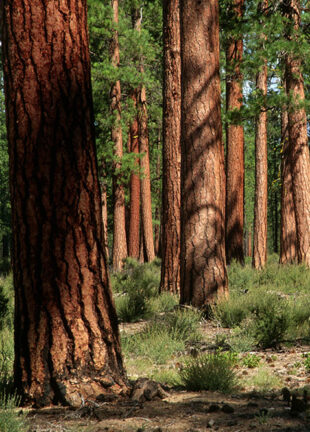The first national inventory of old-growth and mature forests on federal lands was completed this spring in response to Executive Order 14072, issued by President Joseph Biden on Earth Day 2022. The forest inventory report estimates that public lands managed by the Forest Service and the BLM are home to more than 178 million acres of forest, including more than 32 million acres of old-growth forests (18%) and about 80 million acres of mature forests (45%). Forest Service lands account for 24.4 million acres of old-growth forest and 67.4 million acres of mature forest, according to the report. While the forest inventory represents a needed starting point, a close reading of the report provides little motivation for breaking out the champagne.
The forest inventory is based on information compiled by the Forest Service’s Forest Inventory and Analysis (FIA) program, which began in 1930 and defines forest land as “currently or recently having at least 10 percent canopy cover and at least 1 acre in size.” As the federal forest inventory was being prepared, two other studies of mature and old-growth forests were published, as noted by the federal report: “The Federal estimate is larger than DellaSala et al. (2022) and Barnett et al. (2023) when compared at equivalent scale [excluding Alaska] … more than 104 million acres as compared to 53 million acres and 59 million acres respectively.” The federal report attributes these differences to “differing goals and methodologies.”
How the methodologies differ is unclear as the methodology used to define mature forests for the federal inventory is not revealed in the report. To define old-growth forests, “the agencies decided in late fall to apply existing structural old-growth definitions as currently maintained by each Forest Service region. These definitions “were first developed in the early 1990s,” a time when court decisions and endangered species listings made the agencies wary of classifying forests as old growth for fear that they would be prevented from selling the timber. Additionally, the federal inventory report states that the estimates of mature and old-growth forest acreage are subject to a “68 percent confidence interval” — i.e., the numbers have a 32% chance of being wrong.
In introducing the forest inventory findings, the report states, “The initial inventory and definitions for old-growth and mature forests are part of an overarching climate-informed strategy to enhance carbon sequestration and address climate-related impacts, including insects, disease, wildfire risk, and drought.” The report concludes by reiterating these points — i.e., the “next steps” called for in Biden’s executive order. In a statement announcing the release of the inventory report, Department of Agriculture Undersecretary Homer Wilkes repeated these talking points: “Our forest ecosystems and communities are struggling to keep up with the stresses of climate change, whether it’s fire, drought, or insect infestations, it is clear that we must adapt quickly.”
While highlighting the risks from these natural forces, neither government officials nor the report itself mentions logging as a threat to mature and old-growth forests. In fact, the motif established by Biden’s executive order, woven into the inventory report, and reiterated by officials like Wilkes, sets the stage for accelerated logging activity greenwashed as “wildfire mitigation” to enhance “forest resilience.”
Comments from timber industry representatives go further, suggesting that the forest inventory was a waste of time as they push to hasten logging for fire mitigation, which received a massive infusion of cash through the Infrastructure Investment and Jobs Act and the Bipartisan Infrastructure Law. The Federal Forest Resource Coalition represents companies that harvest timber on federal land. The industry coalition’s executive director, Bill Imbergamo, commented on the report: “The Forest Service’s most recent science shows that fire, insects and other factors are leading to large-scale losses in mature forests, not timber harvest…. We hope the Forest Service can get back to implementing the billions of dollars Congress provided to protect our forests from fires, bugs, and disease using proven management techniques, like forest thinning and the creation of fuel breaks.”
A growing body of scientific research refutes Imbergamo’s statement, and he goes on to make demonstrably false statements: “On many National Forests, particularly those east of the Mississippi River, we have millions of acres of older forest that are not producing quality wildlife habitat, sequestering carbon, or providing support for local forest-based economies.”
In conjunction with the forest inventory report, the Forest Service issued an advance notice of the proposed rule for managing mature and old-growth forests. Published in the Federal Register, the notice makes clear the timber industry’s vested interest in thinning forests and creating fuel breaks: “Harvests designed to improve stand health and resilience by reducing forest density or removing trees damaged by insect or disease make up 86 percent of [commercially harvested] acres … within the National Forest System.”
Andy Kerr has provided a brief overview of all three recent inventories of mature and old-growth forests in which he observes, “The Forest Service and the BLM have never wanted to know just how much mature and old-growth (MOG) forest they have. They have rightfully feared that to map the MOG will lead to protection of the MOG from logging.
“Back in the day, when old growth first hit the spotted owl fan, the agencies assured the public that there was no shortage of old growth. However, when pressed to define and count its old growth, the Forest Service steadfastly refused to count and narrowly defined old-growth Douglas-fir as only the most cathedral-like stands … leaving out the vast majority of old-growth forests.”
Now, armed with Biden’s executive order and flush with billions in funding for wildfire-mitigation logging, the agency has changed its tune.



